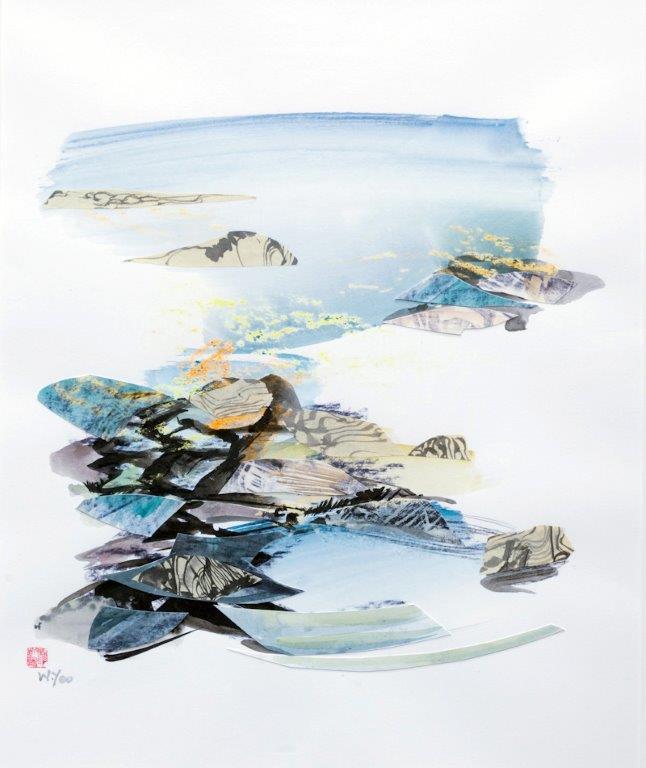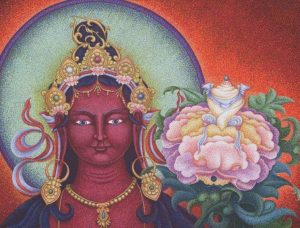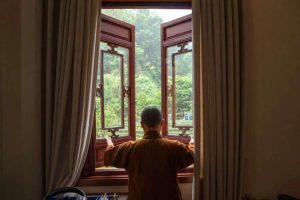
Do religious ideas inspire art, or does the yearning to express art kindle faith? Wendy Yeo R.W.S.W. (Royal Watercolour Society of Wales) has enjoyed a career that has allowed her to explore both questions. Born in Hong Kong but now living in England and Wales, Wendy is a painter of diverse techniques. Thanks to her inspiration by Buddhist thought, she straddles a peculiar line between a secular vocation and spiritual calling. Art is not only entertaining or challenging: it can also be healing, and therefore might serve an almost pastoral function for viewers of the brushstrokes and colors.
“I realize that subconsciously, my work has a lot of Buddhist concepts. I think it’s because I’m very involved with natural forms, and with movement,” said Wendy when I asked if she had any spiritual stimulus for her pieces. The most recent occasion I had seen her paintings was at Art Marco Polo 2014’s show in Wan Chai (the first time being at The Space on Hollywood Road in May 2013). “I have some abstract ideas in my paintings that relate to the sun and the moon. These two objects, I feel, have the strongest feeling of Buddhism—it is the light and the harmony that permeates the surroundings, and I feel that ‘movement’ in my work usually relates to cycles such as birth and rebirth. In Buddhism, this would be known as ‘samsara,’ the wheel of life and death.”
A number of Wendy’s works are collages, which consist of pieces cut from old paintings. For her, this is an expression of the transition from “death” to “rebirth.” “I have used this technique in both watercolour pieces and works on canvas,” she told me. “I am very much involved in movement in nature such as waterfalls—the cycle of ‘rain, waterfall, river, sea, evaporation, clouds, and finally rain again.’” The repeating rhythm of the waves and tides, along with the sunset and sunrise, comprise her favorite theme of continuity in impermanence and rhythmic change. “The world is full of movement and cycles, so it involves ‘Birth,’ ‘Life,’ ‘Death,’ and ‘Rebirth.’”
Wendy’s versatile interests are not limited to collage cuttings. “For watercolour paintings, and any other painting on paper, I always use the Chinese brush,” she said. Her emphasis on movement is often at its best when it’s animated by ebony ink. “I make much use of collage, which I mentioned just now—it’s all about cutting up my own work. I also paint acrylic on canvas. I enjoy using a lot of Japanese handmade paper and often work with mixed media. I use my imagination when using crayon and ink together with collage and watercolor paint.” The result of this meticulous but natural, guileless hybridity is a unique art style that has been at the heart of her interests since childhood.

When she’s in Hong Kong, the media prefer to ask her about her family and her grandmother, Lady Clara Ho Tung. But Wendy enjoys sharing her love of art more. “I have always been passionate about art. I really started painting as early as my memory goes back, at about four years old. It was a way of expression,” she told me. “I carried on drawing and painting all through my school days as a recreation, just as some people would go to their piano or other musical instrument, or play football, although I loved outdoor games as well.”
Her parents regarded art as a hobby, and Wendy focused her academic studies on the pursuit of a profession that was respectable in Hong Kong society, in this case that of a doctor. “However, I became more and more involved in painting, and my parents made it possible for me to have lessons in traditional Chinese painting,” she explained. This was when she also learned Chinese calligraphy, and where her true interests thrived.
“I did a lot of watercolour painting, all the time using the Chinese brush. When it came time to go to university my parents thought that architecture would be nearer to art than a science degree, so I started architecture at The University of Hong Kong. Alongside my university studies I continued to paint a lot. I joined the Hong Kong Art Club and put several paintings in the annual exhibition in 1955—the first time my paintings had been exhibited.”
It so happened that a well-established artist, Madeleine Pearson, had come to Hong Kong from London. She was in the former British colony to explore art education, and encountered Wendy’s work at the exhibition. “She seemed really keen on my paintings, and managed to seek out my parents. She was a very strong and impressive lady, and told my parents that I should really become a painter and that the architecture training would ruin my art!” recalled Wendy. “They were very reluctant for me to give up my architecture course to study art instead. However, Madeleine Pearson was so determined and persuasive that they agreed to send me to England to study art, but only if I was accepted in the best art school in London. I remember being very excited but anxious at the time, as that would be my dream come true.”
Wendy applied to a couple of art schools at the same time, sending relevant work in portfolios. In the end, the Slade School of Fine Art at The University of London accepted her on the strength of her selection and sure enough, her aspiration was realized.
She graduated after three years at the Slade. “I was fortunate to have won various prizes at the time,” she said. She was also awarded a traveling scholarship for a postgraduate year, and credits this particular bursary for inspiring her for further journeys and overseas exhibitions. “During my traveling
scholarship I was able to travel on my own to Italy, absorbing all the wonderful art in that country and working on my own as I went visiting Florence, Venice, and Assisi, and then I spent time working with other artists in an etching studio in Paris.”
Since those early days, she has continued to be inspired by her travels to various countries in Europe, North Africa, India, and East Asia. “Through sketching and absorbing visual impressions of the varied landscapes, after returning home I would often abstract the essence of those traveling impressions when working in my studios in London and Wales,” she said, looking back on several decades of painting. “I have also exhibited overseas in the United States, Kuwait, Istanbul, and Hong Kong, in addition to mainly exhibiting in Great Britain.”
Wendy’s themes also cover the human experience of both nature and civilization. “I enjoy various landscapes when I travel because scenic views embrace more natural forms. Think of waterfalls, seascapes, rivers, and lakes, which create a lot of movement. I am also very involved with cityscapes, in particular London, Venice, Istanbul, and Hong Kong.” She notes that she likes cities on the water and the reflections from sunrise to sunset, which might have led to her choice of places: London has the Thames, Venice is located in the Venetian Lagoon, Istanbul overlooks the Bosphorus, and Hong Kong is a littoral city with islands and coasts.
Wendy enjoys channeling the abstract into manifest forms. These forms are best displayed through the dynamic movement that has become a signature presence on her canvas. Death and rebirth; the sun and moon; landscape and city skyline: Wendy’s “samsaric” symmetries are contrasted and harmonized through the higher dichotomy of abstraction and movement. This has been her artistic and philosophical gift to those who have been lucky enough to encounter her brushstrokes and colors.















